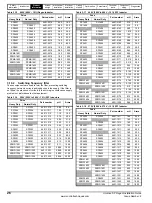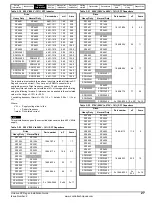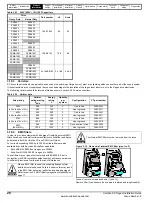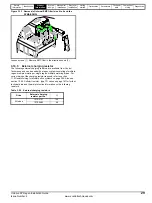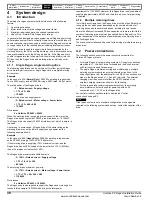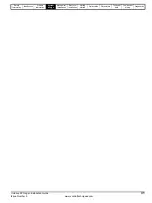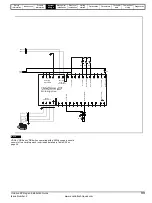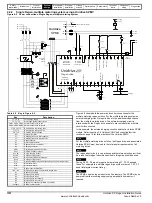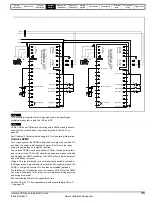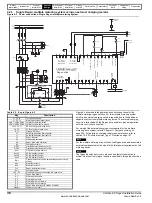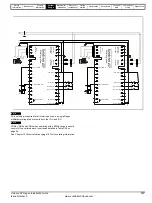
Safety
Information
Introduction
Product
information
System
design
Mechanical
installation
Electrical
installation
Getting
started
Optimisation
Parameters
Technical
data
Component
sizing
Diagnostics
40
Unidrive SP Regen Installation Guide
www.controltechniques.com Issue Number: 2
For the multiple motoring drive solution, the Regen drive and associated
external components must be sized to the total power requirements of all
motoring drives.
The regen inductor duty is very arduous and therefore selection is
critical. As a result only regen inductors specified in this guide should be
used.
VDR4, VDR5 and VDR6 when operating with a 690Vac supply should
consist of two varistors each in series as detailed in Table 3-24 on
page 28.
4.2.5 Regen and motoring drive ratings
N
The Regen drive’s current limits are detailed in section 3.3
page 13.
In general the Regen drive must be rated at a power greater than, or
equal to, the maximum braking power.
Example:
•
Two 30kW motoring drives are each driving 30kW motors. The load
is such that only one drive is braking at a time.
If each motor supplies between 20 and 30kW motoring, and the braking
power varies from 0 to 30kW, the maximum total braking power is 30 -
20 = 10kW, which is what the Regen drive should be rated for.
In drive configurations where the motoring drive power rating is several
times the expected braking power, it is necessary to consider the peak
braking power returned from the load.
Example:
•
The motoring drive is a 75kW Unidrive SP. Motoring power is 75kW.
Steady state braking power is 20kW.
From these figures, it may appear that a 22kW Regen drive will provide
sufficient braking power. However, dynamically the peak braking power
could be much greater. If the 75kW drive current limits are set at 150%
for motoring and braking (default settings), the peak brake power could
be:
√
3
×
156A
×
400V
×
150% = 162kW
This is much greater than the 22kW Regen drive is able to return to the
supply, hence a larger drive is required.
N
If the Regen drive is not rated for the required braking power, then the
drives will trip on DC bus over-voltage.
4.3 Non standard applications
4.3.1 Omitting the switching frequency filter
If the supply to the Regen drive is shared with other equipment, then it is
generally recommended that a switching frequency filter should be
incorporated in order to avoid the risk of interference or damage to the
other equipment. However some saving in cost and space is possible by
omitting the filter if the supply impedance is very low compared to that of
the drive, i.e. if the drive current rating is much less than that of the
supply where it is shared with other equipment.
4.3.2 Supply assessment
The following guidelines should be used when assessing whether or not
a switching frequency filter is required.
Symbols used are:
I
Drive
Nominal drive 100% current rating.
I
SC
Short circuit current of supply at point of coupling with other
equipment.
I
Supply
Rated current of supply.
The switching frequency filter may be omitted if the following relation is
true:
If the short-circuit current is not known, then a reasonable estimate can
be made if it is assumed that the fault current of the supply is 20 times
the rated current. This is very commonly the case where the supply is
derived through a distribution transformer from a higher voltage supply
with a high fault level.
Then:
Note that the short-circuit current data used must be realistic, it must not
be the maximum likely value which is sometimes used when selecting
the interrupting capacity of switchgear and protection devices.
This second relation is helpful if the short-circuit current of the supply is
not known, but must be used with care. It is reliable where the Regen
drive is supplied through its own cable run from a point close to the
distribution transformer terminals. If the Regen drive shares a long cable
run with other equipment, then the effect of the cable impedance on the
fault level must be taken into account if a risk of disturbance to the other
equipment is to be avoided.
This procedure will normally be applied when assessing a non-dedicated
low-voltage supply. It may also be applied to the medium/high voltage
supply where the low-voltage supply is dedicated to the drive. In that
case the currents used must be referred to the high voltage side of the
transformer.
If the supply to the regen system has an unusually high impedance, for
example because it derives from a generator whose rating is not much
greater than that of the drive, then a more complex filter might be
required to ensure stability of the current control loops. Please contact
the supplier of the drive if it is to be used with a generator whose rating is
less than twice that of the drive.
4.4 Cable length restrictions
There are 3 significant cable lengths which must be taken into account
when designing a regen system. Refer to Figure 4-5 on page 41.
4.4.1 AC supply connection
A is the AC cable length between the regen inductor and the Regen
drives terminals.
In general, no special precautions are necessary for the AC supply
wiring in respect to the Regen drive. Ideally, the regen inductors should
be mounted close to the drive terminals.
If it is necessary to use a cable longer than 5m, a screened cable should
be used with the screen grounded.
4.4.2 DC bus connection
B is the length of the DC bus connection between the Regen and
motoring drive, the + DC bus connections between the drives should be
treated as a single two core cable and not two individual cable / bus bar
lengths.
The DC power output from the Unidrive SP which is used as the input
stage to the motoring drive(s) carries a common-mode high frequency
voltage comparable with the output voltage from a standard drive. All
precautions recommended for motor cables must also be applied to all
cables connected to this DC circuit.
NOTE
NOTE
NOTE
NOTE
NOTE
I
Drive
<
1
I
SC
140
I
Drive
<
1
I
Supply
7
Summary of Contents for SP1201
Page 219: ......
Page 220: ...0471 0029 02 ...

